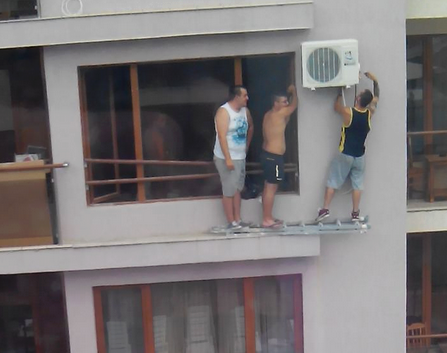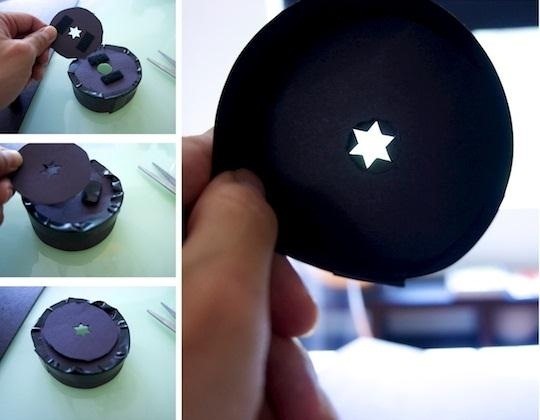Difference between revisions of "Repair and Broken World Thinking"
| (13 intermediate revisions by one other user not shown) | |||
| Line 187: | Line 187: | ||
Stijn | Stijn | ||
| + | |||
| + | |||
| + | '''story''': | ||
| + | a personal record player, that works but not quite well. | ||
| + | |||
| + | |||
| + | '''diagnose''': | ||
| + | The needle jumps up and skips | ||
| + | |||
| + | |||
| + | '''possible Repair''': | ||
| + | Add another device that presses the needle down, so it lays better on the record | ||
| + | |||
| + | |||
| + | '''method''': | ||
| + | possibly a hybrid method? What device do we seee around that can do the job? | ||
==Bike Light== | ==Bike Light== | ||
| Line 193: | Line 209: | ||
| − | story: | + | '''story''': |
| − | diagnose: | + | '''diagnose''': |
leaked and corroded batteries | leaked and corroded batteries | ||
Broken switch, but after cleaning and examination, LEDs function perfectly. | Broken switch, but after cleaning and examination, LEDs function perfectly. | ||
| − | possible Repair: | + | '''possible Repair''': |
energy harvesting bedside lamp | energy harvesting bedside lamp | ||
| − | method: | + | '''method''': |
Hybrid object | Hybrid object | ||
| Line 218: | Line 234: | ||
Anushree | Anushree | ||
| + | |||
| + | '''story''': | ||
| + | |||
| + | |||
| + | '''diagnose''': | ||
| + | no polarization filter, but back-light works perfectly | ||
| + | |||
| + | '''possible Repair''': | ||
| + | a light table? | ||
| + | |||
| + | '''method''': | ||
==Point and shoot digital camera== | ==Point and shoot digital camera== | ||
Chris | Chris | ||
| + | |||
| + | |||
| + | '''story''': | ||
| + | A personal old digital camera. Has not been used for years. | ||
| + | Surprisingly, on its SD card were still some old, forgotten photographs | ||
| + | |||
| + | '''diagnose''': | ||
| + | does not turn on at all. | ||
| + | The battery seems to be drained but there is no charger anymore. | ||
| + | |||
| + | '''possible Repair''': | ||
| + | ''step 1:'' make a fake battery, so we will be able to fit wires inside the camera an power it externally. | ||
| + | |||
| + | '''method''': | ||
| + | |||
| + | LINKS: | ||
| + | [https://hackaday.com/2015/01/21/3d-printed-camera-battery-emulator/ 3d printed battery dummy] | ||
== Keyboard == | == Keyboard == | ||
| Line 227: | Line 271: | ||
Siddhi | Siddhi | ||
| − | == | + | '''story''': |
| + | a keyboard without any internal circuits. The circuitry was used as a material to make shoes from. | ||
| + | |||
| + | '''diagnose''': | ||
| + | a mechanically functioning keyboard shell | ||
| + | |||
| + | '''possible Repair''': | ||
| + | using the keyboard as an output device rather an input. | ||
| + | what if the keys did not get pressed but somehow pushed (from within) as if they are being pushed from within, form a ghost writer | ||
| + | |||
| + | '''method''': | ||
| + | re-purposing | ||
| + | |||
| + | == Analog camera == | ||
Greta | Greta | ||
| + | |||
| + | '''story''': | ||
| + | a camera with a broken lens | ||
| + | |||
| + | '''diagnose''': | ||
| + | the front of the lens is moving and seems to make it difficult to attach lenses to | ||
| + | |||
| + | '''possible Repair''': | ||
| + | after a short disassembly, the fix appears to be easy. There is a missing screw. | ||
| + | Now that lenses can be attached, what does it mean to start creating filters for analog cameras. | ||
| + | we use filters all the time in our digital devices and social media etc... | ||
| + | what are the possibilities of using brokenness and decay as a filter? | ||
| + | |||
| + | example : try to use the broken sock as a filter. | ||
| + | |||
| + | [https://www.fabartdiy.com/how-to-diy-cool-bokeh-filters-out-of-paper/ a diy BOKEH filter?] | ||
| + | |||
| + | [[File:DiyFilter.jpg]] | ||
| + | |||
| + | '''method''': | ||
| + | Hybrid object | ||
== Electric shaver/trimmer == | == Electric shaver/trimmer == | ||
Muz | Muz | ||
| + | |||
| + | '''story''': | ||
| + | an electric shaver, found in the trash | ||
| + | |||
| + | '''diagnose''': | ||
| + | seems to not be able power up. | ||
| + | Possibly broken power adapter, or broken battery charger circuit or both. | ||
| + | Motor functioning normally. | ||
| + | <br> | ||
| + | After charging the battery for a longer time and disassembly, the problem appeared to be mechanical, due to rusting after exposure on rain as a result of being abandoned. | ||
| + | |||
| + | '''possible Repair''': | ||
| + | the emergence of a new tool. a shaving/tattooing machine | ||
| + | |||
| + | |||
| + | '''method''': | ||
| + | Hybrid object | ||
| + | |||
| + | [[Category:Electronics]] | ||
Latest revision as of 13:02, 18 November 2022
Plan
W1 Day 1 / 21.01
09:00 am Meet and greet
Introducion
Disnovation, innovation, improvisation
11:00 am An......a day keeps the doctor away
SPOON
W1 Day 2 / 22.01
09:00 am Meet and greet
collective listening to: Science historian Simon Werrett about Thrifty Science, which discusses historical practices of repair and reuse.
break, discussion
Collective reading of the "Rethinking Repair" by Steven Jackson
File:Jackson RethinkingRepair.pdf
A very short history of trash
Pointers:
- Waste management is related to population density: more people = more waste -> as such: it is a problem relating to the modern era, closely connected to industrialization
- In early history waste was usually discarded in lakes, holes in the grounds or burned.
- The first well known example of large scale waste pollution was London with Corbyn Morris, a London official already saying that "...as the preservation of the health of the people is of great importance, it is proposed that the cleaning of this city, should be put under one uniform public management, and all the filth be...conveyed by the Thames to proper distance in the country". The first occurrence of organised solid waste management system appeared in London in the late 18th century.
- Coinciding with this relocation of waste to landfills, we also see the first recycling: dust-yards selling coal-ash, and the rag-and-bone-men.
- In the mid-19th century, spurred by increasingly devastating cholera outbreaks and the emergence of a public health debate that the first consolidated legislation on the issue emerged. The Nuisance Removal and Disease Prevention Act of 1846 began what was to be a steadily evolving process of the provision of regulated waste management in London. The Metropolitan Board of Works was the first citywide authority that centralized sanitation regulation for the rapidly expanding city and the Public Health Act 1875 made it compulsory for every household to deposit their weekly waste in 'movable receptacles' for disposal - the first concept for a dust-bin. These were collected by removal cars. Similar systems pop up in other cities around the world.
- The dramatic increase in waste for disposal led to the creation of the first incineration plants, or, as they were then called, 'destructors'. In 1874, the first incinerator was built in Nottingham by Manlove, Alliott & Co. Ltd. to the design of Alfred Fryer. The first waste disposal machine!
- Little has changed since 1875; trash is still collected by city initiatives and either destroyed/dumped/recycled. The only change is the scale on which it takes place. MORE trash is burned in BIGGER incinerators/dumped at location even MORE remote/sold through MORE recycling initiatives for MORE money.
- Although consumer electronics such as the television have been popular since the 1920s, recycling of them was almost unheard of until early 1991. The first electronic waste recycling scheme was implemented in Switzerland, beginning with collection of old refrigerators but gradually expanding to cover all devices.
- As of 2014, the European Union had about 50% of world share of the waste and recycling industries, with over 60,000 companies employing 500,000 persons, with a turnover of €24 billion. Countries have to reach recycling rates of at least 50%, while the lead countries were around 65% and the EU average was 39% as of 2013. The EU average rises steadily, to 45% in 2015.
- In 2018, changes in the recycling market have sparked a global "crisis" in the industry. On December 31, 2017, China announced its "National Sword" policy, setting new standards for imports of recyclable material and banning materials that were deemed too "dirty" or "hazardous". The new policy caused drastic disruptions in the global market in recycling and reduced the prices of scrap plastic and low-grade paper. Exports of recyclable materials from G7 countries to China dropped dramatically, with many exports shifting to countries in southeast Asia.
A very short description of object orientated ontology in relation to trash
OOO, not to be confused with, OOP, is a 21st-century metaphysical Heidegger-influenced school of thought that rejects the privileging of human existence over the existence of nonhuman objects. Instead of viewing phenomenal objects as products of human cognition, it tries to consider objects independently of human perception, so not only through their relationship with humans or other objects. This means, amongst other things, thinking about objects beyond mere utility.
How does Harman´s plastic bottle relate to its Umwelt?
»The perceived thing is not an ideal unity in the possession of the intellect; it is rather a totality open to a horizon of an indefinite number of views which blend with one another according to a given style, which defines the object in question.«
What constructs value? What position does waste hold in human society? What is an object? Undermining/Overmining? Rejection of object-subject > objecthood (The philosophical question of the nature of objecthood concerns how objects are related to their properties and relations. For example, it seems that the only way to describe an apple is by describing its properties and how it is related to other things. Its properties may include its redness, its size, and its composition, while its relations may include "on the table", "in the room" and "being bigger than other apples".)
So a consideration of objects as self-contained entities that are not reducable through their relations and properties (metaphysics)
Thinking of waste > what constitutes waste?
What happens when waste is repaired? becomes something else
W1 Day 3 / 23.01
09:00 am Meet and greet
Guest: Joanna van der Zanden
Joanna van der Zanden works as an independent curator with a focus on socially engaged arts and design projects and participatory practices. She has gained a lot of experience in cultural formats where the public at large gets involved in the process of research, questioning and/or making. It is her view that contemporary cultural institutions should – at the best – function as catalysts to stimulate critical and creative thinking and making. Especially in times of paradigm shift, we need to re-educate each other and find new common grounds. Therefore we need open spaces for experimentation and reflection.
worksession: "repair rituals"
W1 Day 4 / 24.01
09:00 am Meet and greet
Critical Making
Guest: Shailoh Phillips---> who is a polymash media artist / researcher / educator.
Critical making is less about the aesthetics of the end product and more about the process and conceptual exploration. It is the inquiry that matters and not the final solution. Through making you get a better understanding of how various technologies function. Critical Making gives birth to curiosity. While making, you question several aspects of the process, explore various directions formulating your own opinion on what works or does not work and why.
The main focus of critical making is open design. Open design develops a critical perspective on the current institutions, practices and norms of society, and reconnects materiality and morality. Matt Ratto introduces Critical Making as processes of material and conceptual exploration and creation of novel understandings by the makers themselves. Critical Making includes digital software and hardware. Software usually refers to the Raspberry Pi or Arduino, hardware refers to a computer, or any other device that facilitates an operation.
REFERENCES:
* Interview Garnet Hertz and Matt Ratto
W1 Day 5 / 25.01
09:00 am Greet and meet and then
The world’s key problems won’t be fixed by simply adding 3D printing,opensource and the Arduino. But how to add them...seriously
W2 Day 6 / 28.01
09:00 am Greet and meet caffeine
Tools for anything crashcourse
Look into and discuss practices of improvised solutions in contexts of limited resources Rikimbili in Cuba (the documentation work of Ernesto Oroza), Gambiara in Brazil ( the practice and writing of Felipe Fonseca), Jugaad in India (hopefully with the blessing and mentoring of Siddhi and Anushree), Halletmek in Turkey and the practice of repair Kintsugi in Japan
W2 Day 7 / 29.01
working on the assignment
W2 Day 8 / 30.01
working on the assignment
W2 Day 9 / 31.01
working on the assignment
W2 Day 10 / 01.02
Brunch and presentations
Assignments
An ..... a day keeps the doctor away
Individual exercise
Every day, we will make a specific object for a maximum of one hour.
This daily exercise aims to train us in the practices of reuse, re-purpose and improvisation.
a spoon
a plate
The never ending life of things
Group exercise (maximum 3 people per group)
Usefulness
A tool when in doubt
Oblique Strategies (subtitled Over One Hundred Worthwhile Dilemmas) is a card-based method for promoting creativity jointly created by Brian Eno and Peter Schmidt, first published in 1975.
Monthly Restart Radio Podcasts on topics like repair and throw-away culture
Technological Disobedience by artist Ernesto Oroza
Some doubts on progress and technology
Texts
References given by Joanna
- Being Ecological, Timothy Morton review of the book from the guardian
- Staying with the trouble, Donna Haraway [2]
Garnet Hertz on Critical Making
Gambiarra: repair culture by Felipe Fonseca
The Craftsman, Richard Sennett (review by the Guardian)
Rethinking Repair,Steven Jackson
Gambiologia magazine - 4th issue 10/2017 "The gambiarra movement"
Repairs
Record Player
Stijn
story:
a personal record player, that works but not quite well.
diagnose:
The needle jumps up and skips
possible Repair:
Add another device that presses the needle down, so it lays better on the record
method:
possibly a hybrid method? What device do we seee around that can do the job?
Bike Light
Hannah
story:
diagnose: leaked and corroded batteries Broken switch, but after cleaning and examination, LEDs function perfectly.
possible Repair: energy harvesting bedside lamp
method: Hybrid object
Walkman 1
Amrith
Walkman 2
Tim
LCD Computer monitor
Anushree
story:
diagnose:
no polarization filter, but back-light works perfectly
possible Repair: a light table?
method:
Point and shoot digital camera
Chris
story:
A personal old digital camera. Has not been used for years.
Surprisingly, on its SD card were still some old, forgotten photographs
diagnose: does not turn on at all. The battery seems to be drained but there is no charger anymore.
possible Repair: step 1: make a fake battery, so we will be able to fit wires inside the camera an power it externally.
method:
LINKS: 3d printed battery dummy
Keyboard
Siddhi
story: a keyboard without any internal circuits. The circuitry was used as a material to make shoes from.
diagnose: a mechanically functioning keyboard shell
possible Repair: using the keyboard as an output device rather an input. what if the keys did not get pressed but somehow pushed (from within) as if they are being pushed from within, form a ghost writer
method: re-purposing
Analog camera
Greta
story: a camera with a broken lens
diagnose: the front of the lens is moving and seems to make it difficult to attach lenses to
possible Repair: after a short disassembly, the fix appears to be easy. There is a missing screw. Now that lenses can be attached, what does it mean to start creating filters for analog cameras. we use filters all the time in our digital devices and social media etc... what are the possibilities of using brokenness and decay as a filter?
example : try to use the broken sock as a filter.
method: Hybrid object
Electric shaver/trimmer
Muz
story: an electric shaver, found in the trash
diagnose:
seems to not be able power up.
Possibly broken power adapter, or broken battery charger circuit or both.
Motor functioning normally.
After charging the battery for a longer time and disassembly, the problem appeared to be mechanical, due to rusting after exposure on rain as a result of being abandoned.
possible Repair: the emergence of a new tool. a shaving/tattooing machine
method:
Hybrid object



